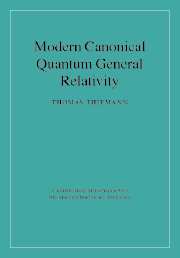Book contents
- Frontmatter
- Contents
- Foreword, by Chris Isham
- Preface
- Notation and conventions
- Introduction: Defining quantum gravity
- I CLASSICAL FOUNDATIONS, INTERPRETATION AND THE CANONICAL QUANTISATION PROGRAMME
- 1 Classical Hamiltonian formulation of General Relativity
- 2 The problem of time, locality and the interpretation of quantum mechanics
- 3 The programme of canonical quantisation
- 4 The new canonical variables of Ashtekar for General Relativity
- II FOUNDATIONS OF MODERN CANONICAL QUANTUM GENERAL RELATIVITY
- III PHYSICAL APPLICATIONS
- IV MATHEMATICAL TOOLS AND THEIR CONNECTION TO PHYSICS
- References
- Index
2 - The problem of time, locality and the interpretation of quantum mechanics
Published online by Cambridge University Press: 04 August 2010
- Frontmatter
- Contents
- Foreword, by Chris Isham
- Preface
- Notation and conventions
- Introduction: Defining quantum gravity
- I CLASSICAL FOUNDATIONS, INTERPRETATION AND THE CANONICAL QUANTISATION PROGRAMME
- 1 Classical Hamiltonian formulation of General Relativity
- 2 The problem of time, locality and the interpretation of quantum mechanics
- 3 The programme of canonical quantisation
- 4 The new canonical variables of Ashtekar for General Relativity
- II FOUNDATIONS OF MODERN CANONICAL QUANTUM GENERAL RELATIVITY
- III PHYSICAL APPLICATIONS
- IV MATHEMATICAL TOOLS AND THEIR CONNECTION TO PHYSICS
- References
- Index
Summary
In this chapter we are going to address the famous ‘problem of time’ which has become the headline for all the physical interpretational problems of the mathematical formalism. Roughly speaking the problem of time is that there is none in GR: at least in the spatially compact case without boundaries the Hamiltonian vanishes on the physical, constraint surface. This is physically relevant because we seem to live in a universe with precisely that spatial topology. Since the Hamiltonian generates time translations in any canonical theory we arrive at the conclusion that ‘nothing moves’ in GR, which is in obvious contradiction to experiment. Since there is no time also the usual interpretation of quantum mechanical measurements at given moments of time breaks down. One can fill books about this issue and we will not even try to cover a substantial amount of the existing literature. A superb source of information on these conceptual problems is Carlo Rovelli's book [3]. Rather, what we will do in what follows is to collect various proposals for solutions to the problem of time taken from other authors, especially Rovelli's relational approach to classical and quantum physics and Hartle et al.'s consistent history interpretation, and combine them into a consistent picture. We do not want to suggest that the resulting picture is to be accepted, rather we want to draw attention to the problems involved and to develop a working hypothesis. The discussion on the interpretation of quantum mechanics is very alive and some authors such as Penrose [243] not only propose to alter the interpretational aspect of quantum mechanics but also the mathematical framework.
- Type
- Chapter
- Information
- Modern Canonical Quantum General Relativity , pp. 74 - 106Publisher: Cambridge University PressPrint publication year: 2007

